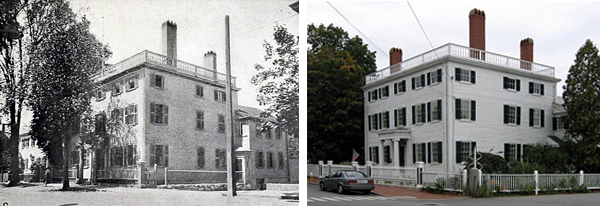 |
| Stone Church (South Church) |
Conditions were perfect for a firestorm, and soon sparks carried by the wind began randomly setting fire to buildings on State Street and the surrounding areas. The town’s firefighting efforts, consisting of water-bucket brigades and hand-pumped engines, were quickly overwhelmed as blazes burned out of control in various locations and continued to spread. Flames from burning buildings on both sides of State Street, which was much narrower than it is today, joined above the roadway and created an arch of fire over the road. Many volunteers dashed into burning houses to rescue furniture and other belongings. Household objects were stacked in the street. Looting occurred during and after the fire, and at least one person fighting the fires had his pocket picked. The inferno grew and grew until light from the fires could be seen as far away as Boston, Massachusetts; Windsor, Vermont; and Providence, Rhode Island.
 |
| Portsmouth Naval Shipyard |
The inferno raged for six hours, until about 1 o’clock on the morning of December 23, before the firefighters got control. Forty people arrived from Salem, MA around three o’clock in the morning and kept an eye on the smoking ashes while exhausted townspeople who had battled the flames all night found somewhere to sleep. The following night, Christmas Eve, Newburyport sent eighty or ninety men to help guard the charred remains and stacks of belongings that littered the streets.
The fire destroyed State Street from the burning barn to the Piscataqua River shoreline and even torched the Portsmouth Pier and all its warehouses at the end of the street. Among the losses was an historic, castle-like mansion once owned by Sheriff Thomas Packer, who was notorious for hanging Ruth Blay, the last woman executed in New Hampshire. The prosperous merchant, James Sheafe, Jr., lost his home on the north side of State Street opposite Washington Street, and the house where Daniel Webster lived, on the northwest corner of Court and Pleasant Streets, also burned. Portsmouth’s library and about a thousand books were lost.
Destroyed were approximately one hundred and eighty homes and sixty-four barns and shops; some estimates put the destruction as high as two hundred and seventy-two buildings. Fifteen acres of the center of Portsmouth were in ruins: 1/3 of a mile from west to east and 1/8 of a mile south to north. Property damages amounted to $250,000 -$300,000. Afterwards, charitable donations of precisely $77,273 were collected.
Losses from this fire were so devastating that the NH Fire and Marine Insurance Company, incorporated after the first Great Portsmouth Fire in 1802, went bankrupt. Their building in Market Square was later sold to the Portsmouth Athenaeum.
As a result of the fire, the third Christmastime inferno to devastate Portsmouth in eleven years (1802, 1806, and 1813), the town voted to request state legislation banning wooden structures over 12 feet –one story high – within the town limits. The resulting “Brick Act” was controversial but resulted in the Portsmouth we know today. Most buildings on State Street, from Pleasant Street to Marcy Street, Daniel Street, and Market Street are brick for this reason.
Years later it was discovered that the barn fire that started it all had been deliberately set by a disgruntled servant of the Widow Woodward. Angry that her employer had confiscated some bottles of wine given to her by a boarder, the young woman retaliated by setting fire to the barn.
Amazingly, not one person died in
The Great Portsmouth Fire of December 22, 1813.



















































